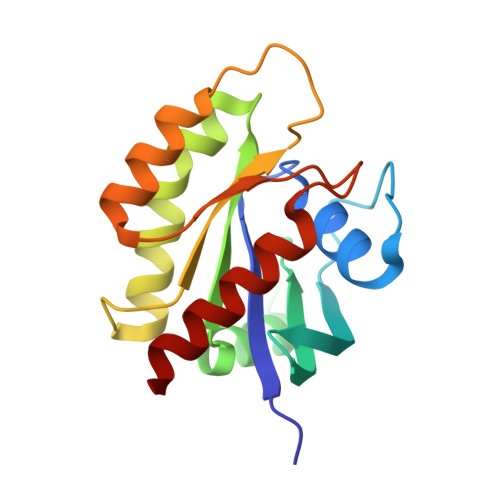Potent and Selective Covalent Quinazoline Inhibitors of KRAS G12C.
Zeng, M., Lu, J., Li, L., Feru, F., Quan, C., Gero, T.W., Ficarro, S.B., Xiong, Y., Ambrogio, C., Paranal, R.M., Catalano, M., Shao, J., Wong, K.K., Marto, J.A., Fischer, E.S., Janne, P.A., Scott, D.A., Westover, K.D., Gray, N.S.(2017) Cell Chem Biol 24: 1005-1016.e3
- PubMed: 28781124
- DOI: https://doi.org/10.1016/j.chembiol.2017.06.017
- Primary Citation of Related Structures:
5V9L, 5V9O - PubMed Abstract:
Targeted covalent small molecules have shown promise for cancers driven by KRAS G12C. Allosteric compounds that access an inducible pocket formed by movement of a dynamic structural element in KRAS, switch II, have been reported, but these compounds require further optimization to enable their advancement into clinical development. We demonstrate that covalent quinazoline-based switch II pocket (SIIP) compounds effectively suppress GTP loading of KRAS G12C, MAPK phosphorylation, and the growth of cancer cells harboring G12C. Notably we find that adding an amide substituent to the quinazoline scaffold allows additional interactions with KRAS G12C, and remarkably increases the labeling efficiency, potency, and selectivity of KRAS G12C inhibitors. Structural studies using X-ray crystallography reveal a new conformation of SIIP and key interactions made by substituents located at the quinazoline 2-, 4-, and 7-positions. Optimized lead compounds in the quinazoline series selectively inhibit KRAS G12C-dependent signaling and cancer cell growth at sub-micromolar concentrations.
Organizational Affiliation:
Department of Cancer Biology, Dana-Farber Cancer Institute, Boston, MA 02115, USA; Department of Biological Chemistry and Molecular Pharmacology, Harvard Medical School, Boston, MA 02115, USA.

















